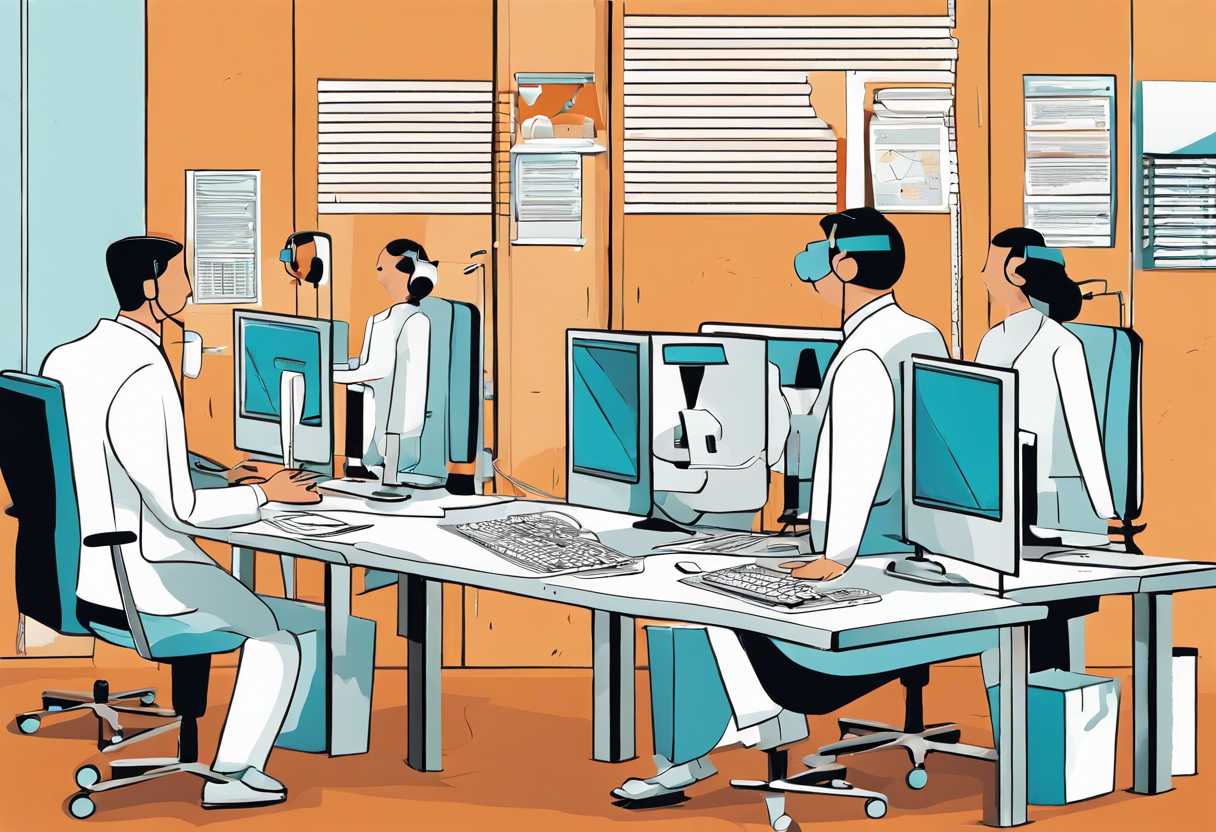When it comes to the organizational structure of customer service, the question of whether it should report to sales or operations is a topic of ongoing debate. The impact of this reporting structure on sales performance, customer satisfaction, and overall operational efficiency cannot be understated. In this blog post, we will delve into the key considerations and implications of customer service reporting to sales versus operations. We will explore the role of operations in customer service management, the effects of customer service reporting to sales on customer satisfaction, and the importance of finding the right balance between sales and operations for an effective reporting structure. Join us as we navigate through the complexities of this crucial decision and uncover the best practices for optimizing customer service reporting structure.
The Impact of Customer Service Reporting Structure on Sales Performance
The Role of Customer Service Reporting Structure
Customer service reporting structure plays a crucial role in the overall sales performance of a company. It determines how customer feedback and issues are handled, which directly impacts customer satisfaction and, ultimately, sales. A well-organized reporting structure ensures that customer service teams are able to effectively address customer concerns and provide timely solutions, leading to improved customer retention and increased sales.
Alignment with Sales Objectives
When the customer service reporting structure is aligned with sales objectives, it can significantly boost sales performance. By having a clear line of communication between customer service and sales teams, issues can be quickly escalated and resolved, leading to higher customer satisfaction and repeat business. This alignment also allows for valuable insights from customer interactions to be shared with the sales team, enabling them to better understand customer needs and preferences, and tailor their sales approach accordingly.
Data-Driven Decision Making
An effective customer service reporting structure enables data-driven decision making, which is essential for improving sales performance. By tracking and analyzing customer service metrics such as response times, resolution rates, and customer feedback, companies can identify areas for improvement and implement strategies to enhance the overall customer experience. This, in turn, leads to increased customer loyalty and higher sales.

Finding the Right Reporting Structure for Customer Service: Sales vs. Operations
Understanding the Differences
When it comes to customer service reporting structures, it’s important to understand the differences between sales and operations. Sales-focused customer service teams are typically more focused on revenue generation and customer acquisition, while operations-focused teams are more concerned with customer retention and satisfaction. Understanding these differences is crucial in determining the right reporting structure for your customer service department.
Benefits of Sales-Focused Reporting Structure
A sales-focused reporting structure for customer service can be beneficial for companies that prioritize revenue generation and customer acquisition. By aligning customer service with the sales team, there is a greater focus on upselling and cross-selling opportunities, as well as a more proactive approach to customer outreach. This can result in increased revenue and a more streamlined customer acquisition process.
Advantages of Operations-Focused Reporting Structure
On the other hand, an operations-focused reporting structure for customer service can be advantageous for companies that prioritize customer retention and satisfaction. By aligning customer service with the operations team, there is a greater focus on resolving customer issues, improving processes, and enhancing the overall customer experience. This can result in higher customer satisfaction, increased loyalty, and reduced churn rates.

The Role of Operations in Customer Service Management
Efficiency and Effectiveness
Operations play a crucial role in customer service management by ensuring the efficiency and effectiveness of the processes involved in delivering exceptional service to customers. By optimizing operational processes, businesses can streamline their customer service operations, reduce response times, and improve overall customer satisfaction.
Resource Allocation and Management
Another key role of operations in customer service management is resource allocation and management. This involves allocating the right resources, such as staff, technology, and tools, to ensure that customer service operations run smoothly and effectively. Operations also play a vital role in managing these resources to meet customer demands and expectations.
Quality Control and Continuous Improvement
Operations are responsible for implementing quality control measures and driving continuous improvement in customer service management. By monitoring and analyzing key performance indicators, operations can identify areas for improvement and implement changes to enhance the quality of customer service. This includes implementing feedback loops, training programs, and process improvements to ensure that customer service operations are always evolving and improving.
How Customer Service Reporting to Sales Affects Customer Satisfaction
The Impact of Customer Service Reporting on Sales
Customer service reporting plays a crucial role in influencing sales. When customer service teams provide detailed and accurate reports to the sales department, it enables the sales team to understand the customer’s needs and preferences better. This, in turn, allows the sales team to tailor their approach and offerings to meet those specific needs, ultimately leading to higher customer satisfaction and increased sales.
Improving Customer Satisfaction through Effective Reporting
Effective reporting from customer service to sales can significantly impact customer satisfaction. By sharing insights on customer feedback, issues, and preferences, the sales team can proactively address any concerns or pain points, leading to a more positive customer experience. Additionally, this information can be used to personalize the sales approach, making customers feel valued and understood, ultimately resulting in higher satisfaction levels.
Enhancing Communication and Collaboration between Departments
When customer service reporting is seamlessly integrated with the sales process, it fosters better communication and collaboration between the two departments. This alignment ensures that customer feedback and insights are effectively communicated and utilized by the sales team, leading to a more cohesive and customer-centric approach. As a result, this collaboration can lead to improved customer satisfaction and loyalty.
Balancing Sales and Operations: The Key to Effective Customer Service Reporting Structure
The Importance of Balancing Sales and Operations
Effective customer service reporting structure requires a delicate balance between sales and operations. Sales teams are focused on meeting customer needs and driving revenue, while operations teams are responsible for ensuring smooth and efficient processes. When these two functions are in sync, customer service reporting becomes more accurate and actionable.
Aligning Sales and Operations for Customer Service Reporting
One way to achieve a balanced reporting structure is to align the goals and metrics of sales and operations teams. By establishing common KPIs and objectives, both teams can work towards the same outcomes, leading to more cohesive reporting. Additionally, regular communication and collaboration between sales and operations can help identify areas for improvement and ensure that customer service reporting reflects the entire customer journey.
The Role of Technology in Balancing Sales and Operations
Technology plays a crucial role in integrating sales and operations for effective customer service reporting. CRM systems, for example, can provide a unified platform for tracking customer interactions and order fulfillment, allowing for more comprehensive reporting. Additionally, data analytics tools can help identify trends and patterns that impact both sales and operations, leading to more informed reporting decisions.
Conclusion
When it comes to the question of whether customer service should report to sales or operations, the impact on sales performance cannot be overlooked. The reporting structure plays a crucial role in determining the effectiveness of customer service in meeting the needs of both the customers and the business.
As we’ve explored the differences between reporting to sales and operations, it’s clear that finding the right balance is essential. While reporting to sales can lead to a more customer-centric approach and improved customer satisfaction, operations also play a vital role in managing the logistics and processes that support customer service delivery.
Ultimately, the key to an effective customer service reporting structure lies in striking a balance between sales and operations. By aligning the goals and objectives of both departments, businesses can ensure that customer service is optimized to drive sales performance while also maintaining operational efficiency.
As you consider the best reporting structure for your customer service team, it’s important to evaluate the specific needs and dynamics of your organization. By taking a strategic approach and prioritizing the alignment of sales and operations, you can create a reporting structure that maximizes the impact of customer service on both customer satisfaction and overall business performance.
Remember, the success of your customer service reporting structure will ultimately depend on the unique context of your business. By carefully considering the insights shared in this blog post, you can make informed decisions that will drive the success of your customer service team and contribute to the growth of your business.
Thank you for reading, and we hope this post has provided valuable insights to help you navigate the complexities of customer service reporting structure.

